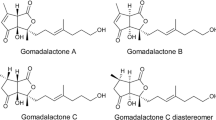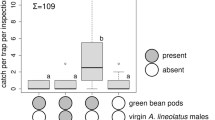Abstract
Female Phytocoris calli Knight produce a sex pheromone from metathoracic scent glands. The pheromone consists of hexyl acetate (HA; present in both sexes), with the female-specific compounds (E)-2-hexenyl acetate (E2HA), octyl acetate (OA), and (E)-2-octenyl acetate (E2OA). HA and E2OA are key components of the pheromone, since deletion of either ester from the blend resulted in a total suppression of conspecific male trap catches. However, the binary blend of HA and E2OA was only slightly attractive to males, and was significantly less active than the four-component blend. The two ternary blends, HA/OA/E2OA and HA/E2HA/E2OA, were each as attractive as the full four-component blend. Evidence from previous research on the pheromones of Phytocoris species suggests that the apparent chemical redundancy in the pheromone of P. calli may actually be involved in maintaining reproductive isolation from other sympatric species. The patterns observed for pheromones of the five Phytocoris species whose pheromones have been directly (P. californicus, P. relativus, P. difficilis, and P. calli) or indirectly (P. breviusculus) studied are discussed vis-à-vis the pheromone intractable species of Lygus and Lygocoris plant bugs.



Similar content being viewed by others
References
Aldrich, J. R., Blsum, M. S., Hefetz, A., Fales, H. M., Lloyd, H. A., and Roller, P. 1978. Proteins in a nonvenomous defensive secretion: biosynthetic significance. Science 201:452–454.
Aldrich, J. R. 1988. Chemical ecology of the Heteroptera. Annu. Rev. Entomol. 33:211–238.
Aldrich, J. R., Lusby, W. R., Kochansky, J., Hoffmann, M. P., Wilson, L. T., and Zalom, F. G. 1988. Lygus bug pheromones vis-à-vis stink bugs., pp. 213–216, in Proc. Beltwide Cotton Prod. Res. Conf. National Cotton Council, Memphis TN, New Orleans, LA.
Aldrich, J. R., Leal, W. S., Nishida, R., Khrimian, A. P., Lee, C.-J., and Sakuratani, Y. 1997. Semiochemistry of aposematic seed bugs (Heteroptera: Lygaeidae). Entomol. Exp. Appl. 84:127–135.
Aldrich, J. R., Oliver, J. E., Taghizadeh, T., Ferreira, J. T. B., and Liewehr, D. 1999. Pheromones and colonization: Reassessment of the milkweed bug migration model (Heteroptera: Lygaeidae: Lygaeinae). Chemoecology 9:63–71.
Aldrich, J. R., Zhang, A., and Oliver, J. E. 2000. Attractant pheromone and allomone from the metathoracic scent gland of a broad-headed bug (Hemiptera: Alydidae). Can. Entomol. 132:915–923.
Byers, J. A. 1991. BASIC algorithms for random sampling and treatment randomization. Comput. Biol. Med. 21:69–77.
Day, R. W., and Quinn, G. P. 1989. Comparisons of treatments after an analysis of variance in ecology. Ecol. Monographs 59:433–463.
Groot, A. T., Drijfhout, F. P., Heijboer, A., Van beek, T. A., and Visser, J. H. 2001. Disruption of sexual communication in the mirid bug Lygocoris pabulinus by hexyl butanoate. Agric. For. Entomol. 3:49–55.
Hirai, K., Shorey, H. H., and Gaston, L. K. 1978. Competition among courting male moths: male to male inhibitory pheromone. Science 202:644–645.
Innocenzi, P. J., Hall, D. R., Masuh, H., Phythian, S. J., Chittamaru, S., Guarino, S., and Cross, J. V. 2004. Investigation of long-range female sex pheromone of the European tarnished plant bug, Lygus rugulipennis: Chemical, electrophysiological, and field studies. J. Chem. Ecol. 30:1509–1529.
Innocenzi, P. J., Cross, J. V., Hesketh, H., and Hall, D. 2005. Attraction of male European tarnished plant bug, Lygus rugulipennis to components of the female sex pheromone in the field. J. Chem. Ecol. 31:1401–1413.
Kakizaki, M., and Sugie, H. 2001. Identification of female sex pheromone of the rice leaf bug, Trigonotylus caelestialium. J. Chem. Ecol. 27:2447–2458.
Leal, W. S., Higuchi, H., Mizutani, N., Nakamori, H., Kadosawa, T., and Ono, M. 1995. Multifunctional communication in Riptortus clavatus (Heteroptera: Alydidae): Conspecific nymphs and egg parasitoid Ooencyrtus nezarae use the same adult attractant pheromone as chemical cue. J. Chem. Ecol. 21:973–985.
Leal, W. S., Ueda, Y., and Ono, M. 1996. Attractant pheromone for male rice bug, Leptocorisa chinensis: Semiochemicals produced by both male and female. J. Chem. Ecol. 22:1429–1437.
Marques, F. A., Mcelfresh, J. S., and Millar, J. G. 2000. Female-produced sex pheromone of the predatory bug Geocoris punctipes. J. Chem. Ecol. 26:2843–2856.
Millar, J. G., Rice, R. E., and Wang, Q. 1997. Sex pheromone of the mirid bug Phytocoris relativus. J. Chem. Ecol. 23:1743–1754.
Millar, J. G., and Rice, R. E. 1998. Sex pheromone of the plant bug Phytocoris californicus (Heteroptera: Miridae). J. Econ. Entomol. 91:132–137.
Millar, J. G. 2005. Pheromones of true bugs. Topics Curr. Chem. 240:37–84.
Schuh, R. T., and Slater, J. A. 1995. True Bugs of the World (Hemiptera: Heteroptera): Classification and Natural History. Comstock Publ. Associates, Ithaca, New York.
Staples, J. K., Krall, B. S., Bartelt, R. J., and Whitman, D. W. 2002. Chemical defense in the plant bug Lopidea robiniae (Uhler). J. Chem. Ecol. 28:601–615.
Stonedahl, G. M. 1988. Revision of the mirine genus Phytocoris Fallén (Heteroptera: Miridae) for western North America. Bull. Am. Mus. Nat. Hist. 188:1–257.
Wheeler, A. G. J. 2001. Biology of the Plant Bugs (Hemiptera: Miridae): Pests, Predators, Opportunists. Cornell University Press, Ithaca.
Zhang, Q.-H., Schlyter, F., and Birgersson, G. 2000. Bark volatiles from nonhost angiosperm trees of spruce bark beetle, Ips typographus L. (Coleoptera: Scolytidae): Chemical and electrophysiological analysis. Chemoecology 10:69–80.
Zhang, Q.-H., and Aldrich, J. R. 2003a. Pheromones of milkweed bugs (Heteroptera: Lygaeidae) attract wayward plant bugs: Phytocoris mirid sex pheromone. J. Chem. Ecol. 29:1835–1851.
Zhang, Q.-H., and Aldrich, J. R. 2003b. Male-produced anti-sex pheromone in a plant bug. Naturwissenschaften 90:505–508.
Zhang, Q.-H., and Aldrich, J. R. 2004. Attraction of scavenging chloropid and milichiid flies (Diptera) to metathoracic scent gland compounds of plant bugs (Heteroptera: Miridae). Environ. Entomol. 33:12–20.
Zhang, Q.-H., Chauhan, K. R., Zhang, A., Snodgrass, G. L., Dickens, J. C., and Aldrich, J. R. 2007. Antennal and behavioral responses of Lygus lineolaris (Palisot de Beauvois) (Heteroptera: Miridae) to metathoracic scent gland compounds. J. Entomol. Sci. 42:92–104.
Acknowledgments
We thank T. J. Henry (Miridae) and Allen L. Norrbom (Milichiidae), Systematic Entomology Laboratory (SEL), USDA-ARS, Beltsville, Maryland, for identification of mirid and milichiid species, respectively. We are also grateful to J. G. Millar, Department of Entomology, University of California at Riverside, for the gift of chemical standards.
Author information
Authors and Affiliations
Corresponding author
Rights and permissions
About this article
Cite this article
Zhang, QH., Aldrich, J.R. Sex Pheromone of the Plant Bug, Phytocoris calli Knight. J Chem Ecol 34, 719–724 (2008). https://doi.org/10.1007/s10886-008-9479-2
Received:
Revised:
Accepted:
Published:
Issue Date:
DOI: https://doi.org/10.1007/s10886-008-9479-2




